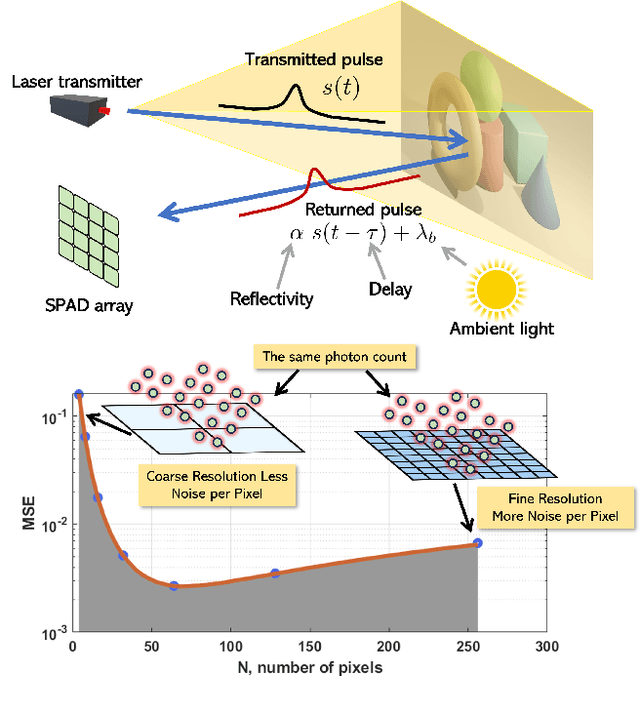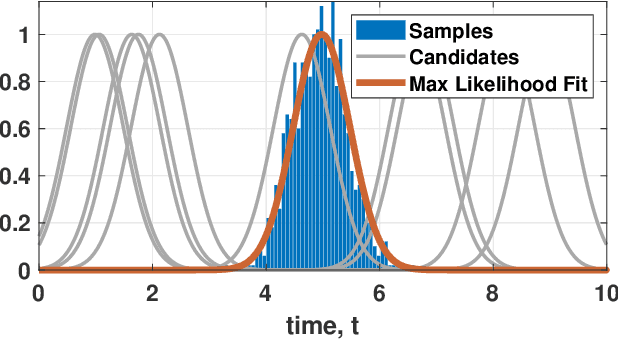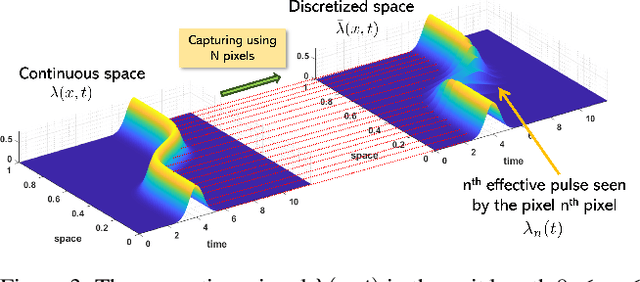Stanley H. Chan
Purdue University
Quanta Diffusion
Jun 07, 2025Abstract:We present Quanta Diffusion (QuDi), a powerful generative video reconstruction method for single-photon imaging. QuDi is an algorithm supporting the latest Quanta Image Sensors (QIS) and Single Photon Avalanche Diodes (SPADs) for extremely low-light imaging conditions. Compared to existing methods, QuDi overcomes the difficulties of simultaneously managing the motion and the strong shot noise. The core innovation of QuDi is to inject a physics-based forward model into the diffusion algorithm, while keeping the motion estimation in the loop. QuDi demonstrates an average of 2.4 dB PSNR improvement over the best existing methods.
Joint Depth and Reflectivity Estimation using Single-Photon LiDAR
May 19, 2025Abstract:Single-Photon Light Detection and Ranging (SP-LiDAR is emerging as a leading technology for long-range, high-precision 3D vision tasks. In SP-LiDAR, timestamps encode two complementary pieces of information: pulse travel time (depth) and the number of photons reflected by the object (reflectivity). Existing SP-LiDAR reconstruction methods typically recover depth and reflectivity separately or sequentially use one modality to estimate the other. Moreover, the conventional 3D histogram construction is effective mainly for slow-moving or stationary scenes. In dynamic scenes, however, it is more efficient and effective to directly process the timestamps. In this paper, we introduce an estimation method to simultaneously recover both depth and reflectivity in fast-moving scenes. We offer two contributions: (1) A theoretical analysis demonstrating the mutual correlation between depth and reflectivity and the conditions under which joint estimation becomes beneficial. (2) A novel reconstruction method, "SPLiDER", which exploits the shared information to enhance signal recovery. On both synthetic and real SP-LiDAR data, our method outperforms existing approaches, achieving superior joint reconstruction quality.
Person Recognition at Altitude and Range: Fusion of Face, Body Shape and Gait
May 07, 2025Abstract:We address the problem of whole-body person recognition in unconstrained environments. This problem arises in surveillance scenarios such as those in the IARPA Biometric Recognition and Identification at Altitude and Range (BRIAR) program, where biometric data is captured at long standoff distances, elevated viewing angles, and under adverse atmospheric conditions (e.g., turbulence and high wind velocity). To this end, we propose FarSight, a unified end-to-end system for person recognition that integrates complementary biometric cues across face, gait, and body shape modalities. FarSight incorporates novel algorithms across four core modules: multi-subject detection and tracking, recognition-aware video restoration, modality-specific biometric feature encoding, and quality-guided multi-modal fusion. These components are designed to work cohesively under degraded image conditions, large pose and scale variations, and cross-domain gaps. Extensive experiments on the BRIAR dataset, one of the most comprehensive benchmarks for long-range, multi-modal biometric recognition, demonstrate the effectiveness of FarSight. Compared to our preliminary system, this system achieves a 34.1% absolute gain in 1:1 verification accuracy (TAR@0.1% FAR), a 17.8% increase in closed-set identification (Rank-20), and a 34.3% reduction in open-set identification errors (FNIR@1% FPIR). Furthermore, FarSight was evaluated in the 2025 NIST RTE Face in Video Evaluation (FIVE), which conducts standardized face recognition testing on the BRIAR dataset. These results establish FarSight as a state-of-the-art solution for operational biometric recognition in challenging real-world conditions.
Wavefront Estimation From a Single Measurement: Uniqueness and Algorithms
Apr 13, 2025Abstract:Wavefront estimation is an essential component of adaptive optics where the goal is to recover the underlying phase from its Fourier magnitude. While this may sound identical to classical phase retrieval, wavefront estimation faces more strict requirements regarding uniqueness as adaptive optics systems need a unique phase to compensate for the distorted wavefront. Existing real-time wavefront estimation methodologies are dominated by sensing via specialized optical hardware due to their high speed, but they often have a low spatial resolution. A computational method that can perform both fast and accurate wavefront estimation with a single measurement can improve resolution and bring new applications such as real-time passive wavefront estimation, opening the door to a new generation of medical and defense applications. In this paper, we tackle the wavefront estimation problem by observing that the non-uniqueness is related to the geometry of the pupil shape. By analyzing the source of ambiguities and breaking the symmetry, we present a joint optics-algorithm approach by co-designing the shape of the pupil and the reconstruction neural network. Using our proposed lightweight neural network, we demonstrate wavefront estimation of a phase of size $128\times 128$ at $5,200$ frames per second on a CPU computer, achieving an average Strehl ratio up to $0.98$ in the noiseless case. We additionally test our method on real measurements using a spatial light modulator. Code is available at https://pages.github.itap.purdue.edu/StanleyChanGroup/wavefront-estimation/.
Learning Phase Distortion with Selective State Space Models for Video Turbulence Mitigation
Apr 03, 2025Abstract:Atmospheric turbulence is a major source of image degradation in long-range imaging systems. Although numerous deep learning-based turbulence mitigation (TM) methods have been proposed, many are slow, memory-hungry, and do not generalize well. In the spatial domain, methods based on convolutional operators have a limited receptive field, so they cannot handle a large spatial dependency required by turbulence. In the temporal domain, methods relying on self-attention can, in theory, leverage the lucky effects of turbulence, but their quadratic complexity makes it difficult to scale to many frames. Traditional recurrent aggregation methods face parallelization challenges. In this paper, we present a new TM method based on two concepts: (1) A turbulence mitigation network based on the Selective State Space Model (MambaTM). MambaTM provides a global receptive field in each layer across spatial and temporal dimensions while maintaining linear computational complexity. (2) Learned Latent Phase Distortion (LPD). LPD guides the state space model. Unlike classical Zernike-based representations of phase distortion, the new LPD map uniquely captures the actual effects of turbulence, significantly improving the model's capability to estimate degradation by reducing the ill-posedness. Our proposed method exceeds current state-of-the-art networks on various synthetic and real-world TM benchmarks with significantly faster inference speed. The code is available at http://github.com/xg416/MambaTM.
Computational Imaging Through Atmospheric Turbulence
Nov 01, 2024Abstract:Since the seminal work of Andrey Kolmogorov in the early 1940's, imaging through atmospheric turbulence has grown from a pure scientific pursuit to an important subject across a multitude of civilian, space-mission, and national security applications. Fueled by the recent advancement of deep learning, the field is further experiencing a new wave of momentum. However, for these deep learning methods to perform well, new efforts are needed to build faster and more accurate computational models while at the same time maximizing the performance of image reconstruction. The book is written primarily for image processing engineers, computer vision scientists, and engineering students who are interested in the field of atmospheric turbulence, statistical optics, and image processing. The book can be used as a graduate text, or advanced topic classes for undergraduates.
Quanta Video Restoration
Oct 19, 2024Abstract:The proliferation of single-photon image sensors has opened the door to a plethora of high-speed and low-light imaging applications. However, data collected by these sensors are often 1-bit or few-bit, and corrupted by noise and strong motion. Conventional video restoration methods are not designed to handle this situation, while specialized quanta burst algorithms have limited performance when the number of input frames is low. In this paper, we introduce Quanta Video Restoration (QUIVER), an end-to-end trainable network built on the core ideas of classical quanta restoration methods, i.e., pre-filtering, flow estimation, fusion, and refinement. We also collect and publish I2-2000FPS, a high-speed video dataset with the highest temporal resolution of 2000 frames-per-second, for training and testing. On simulated and real data, QUIVER outperforms existing quanta restoration methods by a significant margin. Code and dataset available at https://github.com/chennuriprateek/Quanta_Video_Restoration-QUIVER-
Analysis and Improvement of Rank-Ordered Mean Algorithm in Single-Photon LiDAR
Jul 29, 2024Abstract:Depth estimation using a single-photon LiDAR is often solved by a matched filter. It is, however, error-prone in the presence of background noise. A commonly used technique to reject background noise is the rank-ordered mean (ROM) filter previously reported by Shin \textit{et al.} (2015). ROM rejects noisy photon arrival timestamps by selecting only a small range of them around the median statistics within its local neighborhood. Despite the promising performance of ROM, its theoretical performance limit is unknown. In this paper, we theoretically characterize the ROM performance by showing that ROM fails when the reflectivity drops below a threshold predetermined by the depth and signal-to-background ratio, and its accuracy undergoes a phase transition at the cutoff. Based on our theory, we propose an improved signal extraction technique by selecting tight timestamp clusters. Experimental results show that the proposed algorithm improves depth estimation performance over ROM by 3 orders of magnitude at the same signal intensities, and achieves high image fidelity at noise levels as high as 17 times that of signal.
Parametric Modeling and Estimation of Photon Registrations for 3D Imaging
Jul 02, 2024Abstract:In single-photon light detection and ranging (SP-LiDAR) systems, the histogram distortion due to hardware dead time fundamentally limits the precision of depth estimation. To compensate for the dead time effects, the photon registration distribution is typically modeled based on the Markov chain self-excitation process. However, this is a discrete process and it is computationally expensive, thus hindering potential neural network applications and fast simulations. In this paper, we overcome the modeling challenge by proposing a continuous parametric model. We introduce a Gaussian-uniform mixture model (GUMM) and periodic padding to address high noise floors and noise slopes respectively. By deriving and implementing a customized expectation maximization (EM) algorithm, we achieve accurate histogram matching in scenarios that were deemed difficult in the literature.
Resolution Limit of Single-Photon LiDAR
Mar 31, 2024



Abstract:Single-photon Light Detection and Ranging (LiDAR) systems are often equipped with an array of detectors for improved spatial resolution and sensing speed. However, given a fixed amount of flux produced by the laser transmitter across the scene, the per-pixel Signal-to-Noise Ratio (SNR) will decrease when more pixels are packed in a unit space. This presents a fundamental trade-off between the spatial resolution of the sensor array and the SNR received at each pixel. Theoretical characterization of this fundamental limit is explored. By deriving the photon arrival statistics and introducing a series of new approximation techniques, the Mean Squared Error (MSE) of the maximum-likelihood estimator of the time delay is derived. The theoretical predictions align well with simulations and real data.
 Add to Chrome
Add to Chrome Add to Firefox
Add to Firefox Add to Edge
Add to Edge